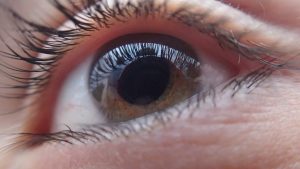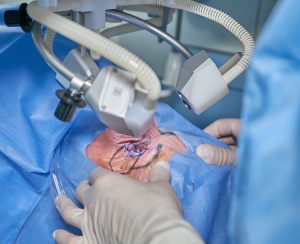
Cataract is the leading cause of blindness in the world. It is a clouding of the lens of the eye that affects the vision. Cataract is a progressive condition, meaning it will become worse over time and can affect both eyes.
Causes of Cataract
There are many potential causes of cataracts, including age-related changes, some medical conditions, medications, environmental toxins, and genetic factors.
Age-related cataracts are the most common type. The lens of the eye naturally begins to stiffen and discolor as a person ages, making it more vulnerable to developing a cataract. This type of cataract usually occurs gradually, and may not cause significant vision loss until later in life.
Medical conditions, such as diabetes, can also contribute to cataracts. People with diabetes are more likely to develop cataracts, due to the damage that the disease can cause to the eye’s lens. Other medical conditions, such as chronic inflammation, may also increase the risk for cataracts.
Steroids can also cause cataracts due to their effects on the eye’s lens. The use of certain antibiotics and chemotherapy drugs can also increase the risk of developing a cataract.
Environmental toxins, such as cigarette smoke, can also increase the risk of cataract development. The chemicals in cigarette smoke can damage the eye’s lens, weakening it and making it more vulnerable to cataract formation. Exposure to other environmental toxins, such as radiation, can also increase the risk.
Genetics can play a role in the development of cataracts. If there is a family history of cataracts, people may be more likely to develop a cataract in their own lifetimes.
Symptoms of Cataract
The most common symptom of cataracts is blurred vision. The lens of the eye gradually becomes clouded, which impairs your ability to see even when wearing glasses or contact lenses. You may also experience difficulty seeing at night and increased sensitivity to bright light. Colors may also become less vibrant and you may have difficulty recognizing faces.
Other symptoms of cataract may include double vision, a halo effect, or glare. These glare effects can increase with the amount of light. For instance, nighttime glare can be particularly bothersome when driving. You may also experience frequent eyestrain, headaches, or dizziness.
Though cataracts can affect both eyes, it’s possible for one eye to be more affected than the other. If this is the case, you may notice that objects may appear to be tilted or crooked, or that one eye appears to be out of focus when compared to the other.
Diagnosis of Cataract
The first step in diagnosing cataract is to perform a comprehensive eye exam. During this exam, the eye doctor will examine the front of the eye, including the cornea and lens, for any signs of cataracts. The doctor will also check the eye for signs of other eye conditions that could be causing vision loss.
The next step is to perform dilation of the pupils. During dilation, the doctor will use eye drops to temporarily enlarge the pupils. This allows the doctor to get a better view of the back of the eye and the lens. The doctor will also use a magnifying device to look for any changes in the lens that could be indicative of a cataract.
The third step is to test the vision. The doctor will use a chart to measure the sharpness of the patient’s vision. The chart is used to measure the patient’s ability to see letters and shapes at different distances. Usually, if the patient is having difficulty seeing certain letters or shapes at a certain distance, then that may be a sign of a cataract.
The fourth step is to use imaging tests to get an even more detailed look at the eye. The most common imaging test used to detect cataract is an ultrasound. This procedure uses sound waves to look at the lens and determine if there are any changes in its structure that could indicate a cataract. Other imaging tests that can be used to diagnose cataracts include a computerized tomography (CT) scan and a magnetic resonance imaging (MRI) scan.
Prevention of Cataract
The most important step in preventing cataract is to protect your eyes from the damaging effects of ultraviolet (UV) radiation. This includes wearing sunglasses that have UVA and UVB protection when outdoors, and avoiding prolonged exposure to bright sunlight or other sources of bright light. It’s also important to wear protective eyewear whenever engaging in activities where your eyes may come into contact with hazardous materials, such as welding or sandblasting.
Another important preventive measure is to maintain a healthy lifestyle. High blood pressure, diabetes, and smoking can all increase the risk of developing cataract, so it’s important to keep these conditions under control by following a healthy diet and performing regular exercise. It’s also important to have regular eye exams to monitor for any developing eye conditions, including cataract.
Nutrition can also play an important role in preventing cataract. Eating a balanced diet with plenty of fruits and vegetables, as well as foods rich in antioxidants, can help protect the eyes from the oxidative damage that can lead to cataract. Antioxidant-rich foods include dark leafy greens, orange and yellow fruits and vegetables, and nuts and seeds. Eating fish that are high in omega-3 fatty acids, such as salmon and tuna, can also help protect the eyes.
Finally, it’s important to stay hydrated. Drinking plenty of water throughout the day helps keep your eyes healthy and can reduce the risk of cataract, as dehydration can increase oxidative stress in the eye. It’s also important to get enough sleep, as this can help to reduce the risk of developing cataract.
Treatment of Cataract

The treatment for cataract depends on the type of cataract and the extent of vision loss. In most cases, cataract surgery is the best option for treating the condition. This type of surgery involves removing the cloudy lens and replacing it with a new, clear one. This is done with an ultrasound device that breaks up the clouded lens, and then a new lens is inserted. It is a relatively safe and straightforward procedure that can be done on an outpatient basis with minimal recovery time.
In some cases, medications may be prescribed to slow the progression of the cataract or reduce the symptoms. These can include topical ocular steroids, which can reduce inflammation and discomfort, or ocular vitamins, which can help to slow the clouding of the lens. Anti-glaucoma medications may also be prescribed as part of the treatment plan.
In addition to medication and surgery, lifestyle changes can also help to reduce the symptoms of cataract. Wearing UV-protective sunglasses and a wide-brimmed hat when outdoors can help to reduce sun exposure to the eyes and can help to slow the progression of the cataract. Eating a healthy diet, quitting smoking, and taking preventative measures against eye strain can also help to reduce symptoms.
In cases of advanced cataract, a corneal transplant may be recommended. This procedure involves removing the cloudy lens and replacing it with a healthy cornea from a donor. This can be a more invasive procedure and requires a longer recovery period, but it is the most effective treatment for advanced cataracts.